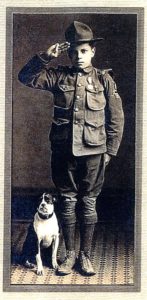While looking for the picture of G.E. Wilson, the Edwards County Food Administrator mentioned in Post #41, I came upon this picture of his son, Robert, in a Wilson-Thornberry Family History book given to the library. it is labeled “Bob Wilson & Tuffy.”

In Post #42 I reported that the Boy Scouts were distributing tags for shovels to remind people to conserve coal. Then, this week, while reading the February 14, 1918 issue of the Kinsley Graphic, I found the following article which ties these things together.
“A Neighborhood General
Not all the able generals helping to win this war are on the French front or in the training camps not all of them have yet been given the commissions they have earned by valuable service in their country. We have one in our neighborhood in the uniform of a Boy Scout and his initials are Robert Wilson. He is busy all the time seeing that we do our part. He made everybody buy Liberty Bonds, and has sold $7,100 in the two drives. For selling the first 10 he received a medal and certificate with the president’s signature and having sold 30 bonds has another coming.
He brings us all the literature from the food conservation department, not leaving it on the porch, but seeing that you get it. He tags our shovels, and buys Thrift Stamps and Baby Bonds. We suggest that Hoover make him food dictator for our neighborhood which is known all over town as “Piety Park.” If he was we should have to toe the mark in saving food to win the war.
He sets all of the grown-ups in Piety Park such an example of earnest sincere work in doing his part that we all do our part of war work a little better.
This young soldier, working between school hours for his country, is the youngest of the four sons of Mr. and Mrs. G. E. Wilson. His biggest brother, Albert, is in the medical reserve at Great Lakes Training camp.
Robert is doing more than his share to whip his imperial malignity, the German Kaiser.”
This article was written a week before Robert Wilson’s fifteenth birthday. And just a note about “Piety Park” mentioned in the article. It was what the local people called the homes in the vicinity of all the churches — from the Methodist on Marsh Street, to the Congregational, Episcopal, Christian Christ on Niles Avenue, and the Church of Christ a little further down Eighth Street. The Wilson home was at 321 Eighth Street, just about across the street from where the old Church of Christ stood.
